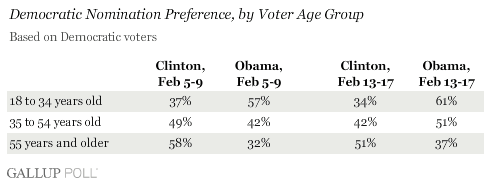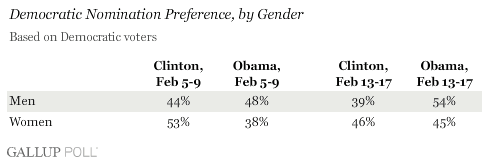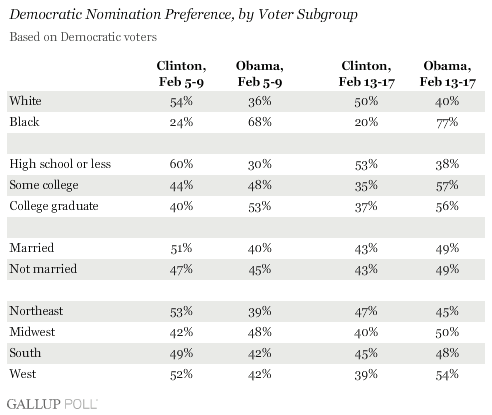PRINCETON, NJ -- The momentum in the Democratic nomination race has clearly swung toward Barack Obama. Not only has he won all of the post-Super Tuesday contests, but he has steadily gained in Gallup Poll Daily tracking to the point where he has overtaken Clinton as the national leader for the first time, holding a statistically significant lead in each of the last three tracking poll results.

Obama's standing has improved among most Democratic subgroups over the past several days. But one of the more substantial shifts has been the changing preferences of middle-aged Democratic voters, who have moved away from Clinton and toward Obama in the past week. Obama has also made gains among three other groups that have favored Clinton throughout much of the campaign -- women, Hispanics, and self-identified Democrats. Obama and Clinton are now running even among these three key groups in the most recent Gallup tracking data.
These findings are based on a comparison of Democratic voters' nomination preferences in Feb. 5-9 polling with those in Feb. 13-17 polling. Each of these five-day tracking periods consists of interviews with roughly 2,000 Democratic voters nationwide. Overall, in the Feb. 5-9 data, Clinton led Obama by an average of 49% to 42%. In the most recent five days (Feb. 13-17), the candidates' standings have basically flipped, with Obama leading Clinton by an average of 49% to 43%.
The Age Effect
Throughout the campaign, exit polls have shown that Obama has appealed to younger voters, and Clinton to older voters. Even as the momentum has swung in Obama's favor, those basic relationships at opposite ends of the age spectrum still hold. The change in recent days has been in middle-aged Democratic voters' preferences. In the Feb. 5-9 period, Clinton led among Democratic voters aged 35 to 54 by a 49% to 42% margin. Now, Obama is the leader among this group by 51% to 42%.

This suggests that middle-aged voters will be a key swing group to monitor in the remaining Democratic primaries and caucuses. For the moment, Obama has captured their allegiance.
The Gender Gap
Clinton's primary victories to date have been fueled in large part by support from female voters. The former first lady and current New York senator has always demonstrated a particular appeal to women.
When Obama has closed the gap with Clinton nationally -- as he did in the days leading up to Super Tuesday (see "Hillary Clinton's Gender Advantage Over Obama Narrows" in Related Items) -- he has usually been able to do so by reducing her lead among women.
In the days immediately after Super Tuesday, Clinton rebuilt her lead among women, enjoying a 53% to 38% lead in the Feb. 5-9 polling. But her gender advantage has once again dissipated, and in the latest data, female Democratic voters are about as likely to say they prefer Obama (45%) as Clinton (46%).

Hispanics
Many credited Clinton's strong appeal to Hispanics for helping her win the important Feb. 5 California primary, and her support among this key group gives the campaign hope for a comeback victory in the March 4 Texas primary. But the tracking data suggest her support advantage among Hispanics may be eroding, at least on a national level. In the Feb. 5-9 data, Clinton led Obama by nearly 2-to-1, 63%-32%, among Hispanic Democratic voters. In the most recent polling, the two are essentially tied among this constituency, with 50% preferring Obama and 46% Clinton.

Party ID
Clinton looked like a solid bet for the nomination early in the campaign process not only because of her consistent lead, but also because she was typically the preferred choice among core Democrats (those who identify as Democrats when asked to give their party affiliation). Meanwhile, Obama tended to fare better among those who initially identify as independents but then say they "lean" to the Democratic Party.
In the Feb. 5-9 data, Clinton continued to lead Obama, 51% to 41%, among Democratic identifiers, while trailing slightly (48% to 42%) among independents. In the most recent results, Obama has expanded his lead among independents (58% to 36%) while achieving parity with Clinton among core Democrats (46% Obama, 45% Clinton).

Other Democratic Voter Groups
The following table shows how the race has shifted among other Democratic voter groups of note.

Among the highlights:
- Obama has further expanded his dominant positioning among black Democrats.
- Both candidates have maintained their leads among their core supporters by education -- Clinton among those with less formal education and Obama among college graduates. The middle group of those who attended college but did not graduate shows movement toward Obama in the latest polling.
- Married Democratic voters have shifted from a Clinton-leaning to an Obama-leaning group.
- Clinton's leads among Democrats in the Northeast and West have dissipated.
Survey Methods
Results are based on telephone interviews with 2,072 national Democratic voters, aged 18 and older, conducted Feb. 5-9, 2008, and 2,022 national Democratic voters, aged 18 and older, conducted Feb. 13-17, 2008, as part of Gallup Poll Daily tracking. For results based on these samples, one can say with 95% confidence that the maximum margin of sampling error is ±2 percentage points.
Margins of error for subgroups of Democratic voters will be larger.
Interviews are conducted with respondents on land-line telephones (for respondents with a land-line telephone) and cellular phones (for respondents who are cell-phone only).
Interviews are conducted in Spanish for respondents who request a Spanish-language interview.
In addition to sampling error, question wording and practical difficulties in conducting surveys can introduce error or bias into the findings of public opinion polls.
